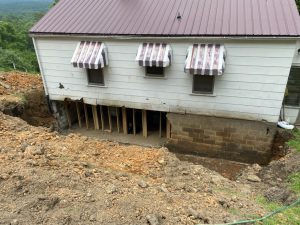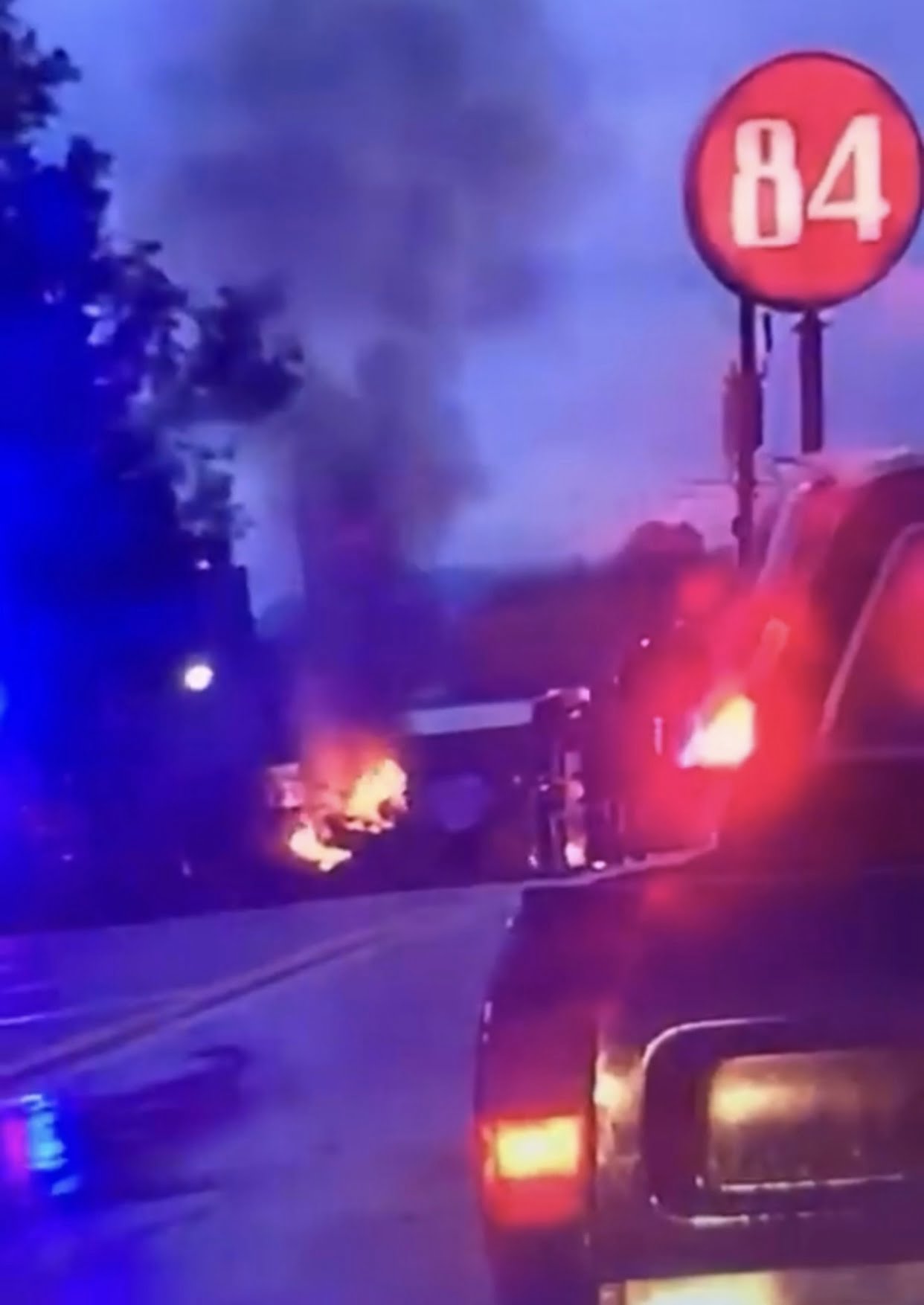By Lyra Bordelon – bobby@mountainmedianews.com
After the June 22 storm in Alderson, the Greater Greenbrier Long-Term Recovery Committee (GGLTRC) is continuing to push for work and donations in order to help at least 85 damaged properties throughout three counties. While federal disaster money and local nonprofits have been impacted by COVID-19 economic damage, limiting recovery funding, natural disasters continue to happen in the Greenbrier Valley. For one of the homes around Flat Mountain, its foundation couldn’t take the extra stormwater, busting the cinderblock wall open, dumping blocks, debris, dirt, and more into the basement.
“We’re surviving the craziness,” said Kate Wood, owner of the damaged home. “It’s amazing though, I’ve been coming down here for 20 years and I’ve never heard of … water being up on this hill. We don’t even know where it came from and all the sudden it was here. Right where [we’re] standing, it looked like a waterfall on these steps.”

Flooding in Alderson is typically the result of more rain in the river, causing the water level to rise. However, in June, much of the flooding came from down the mountain, bringing mud slides, water, and extremely wet soil to places that typically don’t see that.

“The ground was so saturated and the house was just old so it wasn’t built to code, [or] what code is now. It collapsed their foundation wall,” explained Kayla McCoy, executive director of GGLTRC. “Preliminary estimates on this house to repair its foundation are [around] $10,180. It’s going to be more than that because they’ve got to go down both sides of the wall.”
Since the rains over a month ago, the Woods are waiting for contractors, funds, and attempting to fix what they can. In order to help, Christian Aid Ministries cleaned out muck from the basement, and All Construction dug around the home, exposing the foundation wall.

“[The volunteers] cleaned the mud and the water out. It really helped,” Wood said. “The next day, the contractor came in and dug that out for us. We’ve only had one hard rain since then and that almost took us back to the beginning.”
Woods’ property is just one of many after the June 19 storm around Alderson.
“We have 85 affected properties – I’m still working on the breakdown of how many basements, how many crawl spaces, how many interiors, how many yards,” McCoy said. “We’re still performing assessments on those properties. … We have assessments on 23 properties and its $400,000. I’ve still got 62 properties to assess and determine remaining financial need. I don’t even have a full picture yet.”
Days after the storm, residents and town government discovered they would not be eligible for the federal emergency dollars often distributed by entities like FEMA to mitigate disaster recovery. In order to qualify for a Federal Disaster Declaration, the damages must surpass $2.8 million. Currently, state damages are estimated around $914,000. In place of that, the Greenbrier Valley, including Pocahontas, Monroe, and Greenbrier counties represented by GGLTRC, must take care of its own after this disaster.
“My initial fundraising goal was $250,000,” McCoy said. “That was when I thought I had 50 impacted households. The numbers just continue to go up as I find more affected properties. We’ve only found two people that were affected that have insurance. For a lot of these people, their damage doesn’t qualify for their home owners insurance. They’re out of the flood plain, so they’re not required to carry flood insurance.”
Donations for both repairs and future flood damage are essential – in addition to not having federal funds, many of the organizations that donate to the Long Term Recovery Committee are currently unable to because of COVID-19.
“COVID has drastically impacted fundraising efforts,” McCoy said. “We have received funding from a specific nonprofit in Lewisburg every year we’ve been in existence. They gave us our start-up grant, they’ve contributed to our projects. Last year they gave us $10,000. This year we asked for $10,000 but they had to cancel their largest fundraising event of the year, the day they raise $35,000. So they’re capacity to give is not what it’s been in years past, so they denied our request for $10,000 for a different purpose. Every single grant application that I have sent out this year has either been denied or the award has been reduced or the application has been tabled. A lot of these funds, the COVID-19-related market crash decimated them.”
As fundraising continues, efforts to clean and repair are still ongoing. Shortly after the storm, the National Guard entered Alderson in order to remove road-side debris pulled from homes. Despite truck-fulls of debris being removed, there are still piles in the city needed to be taken away. The town and the recovery committee are both pushing to get this trash out.
“There are houses that didn’t even get looked at until the guard was gone,” McCoy explained. “We [now] have to coordinate debris removal with volunteer teams, with the county commission, to get it paid for if it’s out of city limits, and the town of Alderson, on top of all of their regular duties. Debris removal is an ongoing thorn in the side of anyone who’s ever worked in a disaster. It keeps coming out.”
McCoy emphasized the city was doing all it could; natural disaster clean up is a process that can take months, if not years, even when the National Guard helps.
“There’s this perception that when the National Guard comes in, they’re going to do it all and that it’s going to be cleaned up immediately. That’s not the case; if you don’t have the manpower to get the stuff to the curb,” McCoy said. “The guard can’t go into [people’s] homes. We have some houses that we didn’t know needed help until after the fact. … I just want to defend the town in that regard. … This is a all hands on deck kind of staff, which is the case in most small towns. I know it’s the same way in White Sulphur, I know its the same way in Rainelle, everybody does everything.”
Those looking to help can donate funds by visiting ggltrc.org, going to facebook.com/GGLTRC and clicking the fundraiser, or by mailing checks to GGLTRC, 945 Washington Street W, Ste 5, Lewisburg, WV, 24901.
“We thank y’all for all the help you’ve given us,” Wood said. “We would’ve never got this dug out [without help].”



